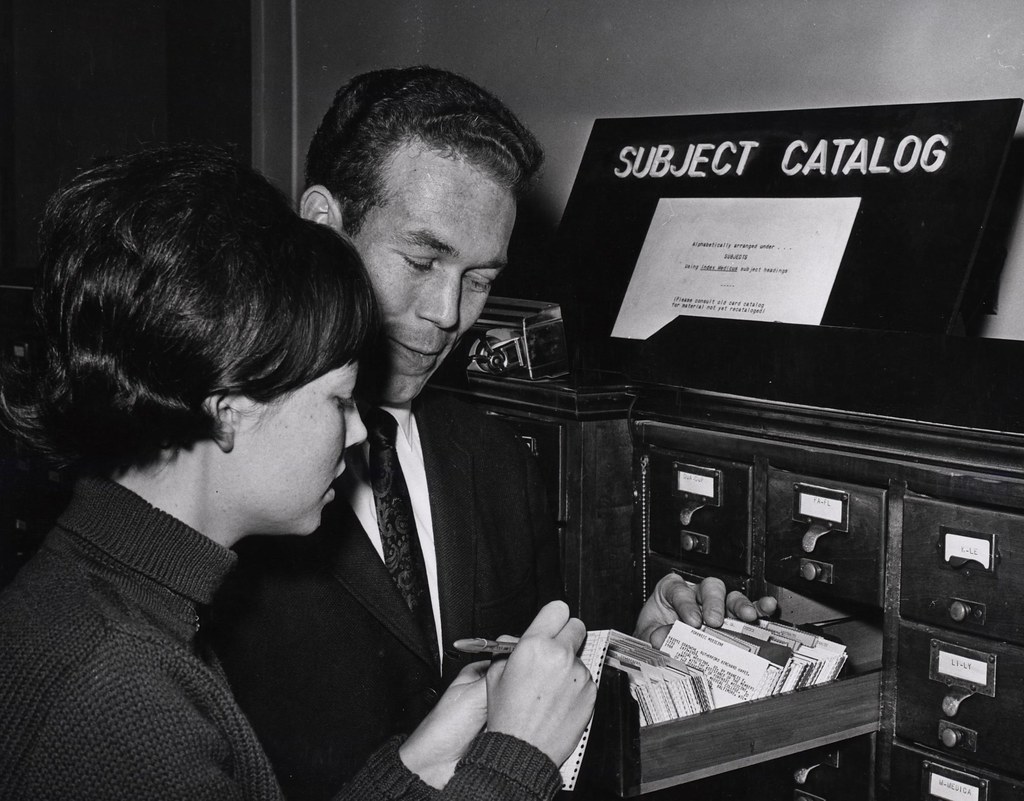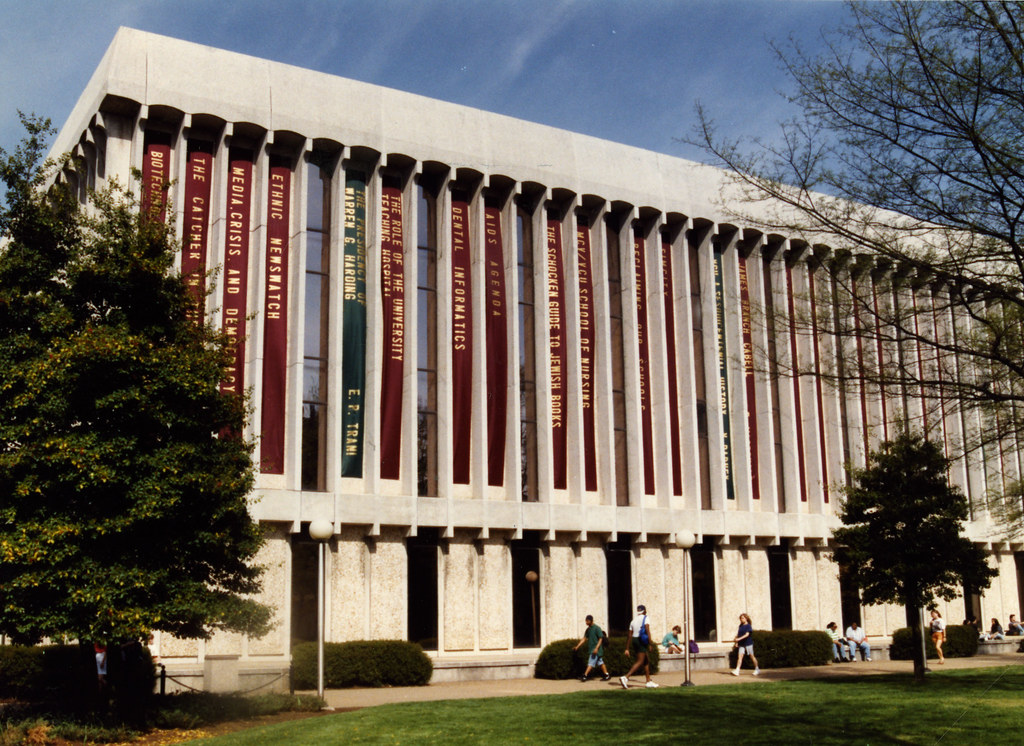History of VCU Libraries

When Virginia Commonwealth University began operating on July 1, 1968, it inherited the two existing libraries from its predecessor institutions, the Medical College of Virginia (MCV) and the Richmond Professional Institute (RPI). Although RPI President George Oliver had appointed N. Harvey Deal to be director of all libraries for the new university, Deal's untimely death in March of 1970 precluded the development of a university-wide library system. That task fell to his successor Gerard B. McCabe who arrived at VCU in August of 1970 and took steps to mold the two former college library operations into one. During the formative years of the entity known as the University Libraries, the administration and the staff focused on the construction of what would become the James Branch Cabell Library on the old RPI campus and a major expansion of what was then known as the Tompkins-McCaw Library on the MCV Campus. When the buildings were completed in 1975, they provided collection space for a million and a half volumes and seats for 2,500 users. With these expanded facilities, the University Libraries embarked on an aggressive collection-building campaign and the expansion of services to meet the needs of a growing urban research university.
To manage its collections and services more expeditiously, University Libraries purchased its first computer system in 1981. By automating operations over the next decade, the organization, now known to the VCU community as University Library Services (ULS) and led by Dr. William Judd, survived staffing and budget cuts of the 1980s. Two major administrative reorganizations in this time frame, including mergers of functional departments across library buildings and the addition of the university’s media production service to library operations, sustained ULS and provided new opportunities for programming, services, and fundraising.

ULS had even more opportunities to support the teaching, learning, research, and patient care mission of the university in the early 1990s with the arrival of VCU’s fourth president, Dr. Eugene Trani and a new library director, Barbara Ford. The adoption of a new integrated library system in 1990 allowed ULS to offer remote searching of not only the library’s catalog but bibliographic databases supporting the research enterprise. ULS subscribed to its first online journal, secured a new collection funding formula, constructed computer classrooms within its buildings, created its first web pages, initiated its digital library, compiled a portfolio of public and private grants, and celebrated the addition of the millionth volume to its collection all before the 20th century came to a close.
ULS entered the 21st century under new leadership and with a new name, the VCU Libraries. With John Ulmschneider at the helm for almost two decades, the VCU Libraries matured and took its place at the heart of VCU, both physically and intellectually, with the awarding-winning expanded Cabell Library, the robust electronic and digital collections, and the outstanding services provided by a dedicated and knowledgeable faculty and staff. As the VCU Libraries enters its sixth decade, it continues to build on its strong foundation and expand its role in support of student success, teaching, experiential learning, research, and patient care under the leadership of Dr. Irene Herold.
VCU Libraries Timeline
1968
- University Libraries is created with the formation of Virginia Commonwealth University
- N. Harvey Deal is appointed first director of libraries
1969
- Librarians begin conducting bibliographic searches for faculty and staff
1970
- Cabell Library opens, replacing the former Richmond Professional Institute Library in the old Anderson Gallery
- Virginia Medical Information System (VAMIS) is established at Tompkins-McCaw Library to facilitate the dissemination of information to health care practitioners
- Gerard B. McCabe is appointed Director of University Libraries
1971
- Coin operated copy machines are installed in the libraries
- University Libraries becomes a Federal Depository Library for U.S. Government Publications
- Librarians begin online searching through Bibliographic Retrieval Services (BRS)
1973
- Automated checkout of library materials begins, using computer punch cards
1974
- New addition to the Tompkins-McCaw Library is dedicated
1975
- University Libraries begins cataloging through OCLC, a national cataloging collaborative
- Top three floors of Cabell Library are completed
- Special Collections and Archives departments are organized in both libraries
1976
- Cabell Library is formally dedicated
- Clinical Medical Librarian program begins
1977
- Union catalog created for Cabell and Tompkins-McCaw libraries
1979
- Book Art Collection is established
1980
- Computer Output Microfiche (COM) catalog is initiated
1981
- University Library Services (ULS) is created by combining the University Libraries and the Visual Education Department
1983
- William J. Judd becomes director of ULS
- Automated circulation using Data Phase Automated Library Information System (ALIS) begins
- Friends of the Library is organized in May
- Libraries receive a portion of grant overhead funds for the first time
1984
- Staff desktop computers are installed
1985
- Academic Computing moves into the basement of Cabell Library
- Cabell Library is designated first official U. S. Patent Depository Library in Virginia
- End-user database searching begins
- Renovation of room 230 in Cabell Library for staff areas
1986
- Online public access catalog (ALIS) is introduced
- Library Development Office is created
1988
- Serials cancellation project where approximately 1650 titles cancelled
1989
- VCU Libraries is designated as Virginia's AIDS resource library
1990
- Library offers service via email
- Library sets up Local Area Network (LAN)
- MEDLINE available on the library's catalog platform for end-user searching
- NOTIS integrated library system is implemented
1991
- Barbara Ford becomes director of ULS
1992
- Libraries subscribe to its first electronic journal, Online Journal of Current Clinical Trials
- New university funding model is put in place to support building research collections
1993
- One millionth volume added to the collection
1994
- Libraries founding member of the Virtual Library of Virginia (VIVA)
1995
- VCU Libraries first web page
- Tompkins-McCaw Library consolidates public services and opens a single-service point
- VCU Card is used for circulation
1997-1998
- Barbara Ford serves as president of the American Library Association
1998
- "My Library" personalized web page option is offered to the VCU community
- New computer classroom TompCAT opens at Tompkins-McCaw
- VCUQatar opens a library
1999
- Electronic Course Reserve service begins
- John Ulmschneider becomes the University Librarian
2000
- ULS becomes VCU Libraries
2001
- First electronic theses and dissertations are added to the collections
- My Library Record service begins where VCU users may view their circulation record and renew books online
- VCU Libraries initiates a chat service to help patrons with their information needs
2002
- Cabell and Tompkins-McCaw Libraries are renovated and coffee bars are opened in each building
- First Lady Laura Bush dedicates the Community Health Education Center (CHEC) in the new Gateway Building
2003
- VCU Libraries adopts ALEPH 500 integrated library system for acquisitions, circulation, reserves, and other library functions
2005-2006
- Jean Shipman serves as president of the Medical Library Association
2007
- Opening of renovated Cabell Special Collections and Archives and the John Mapp Graduate Study Room
- Starbucks opens at Cabell Library
2009
- Two millionth volume is added to the collection
- Off-site storage facility created at 500 Academic Center
2010
- Learning Commons at Cabell Library opens
2011
- Tompkins-McCaw Library opens its first floor gallery for exhibits of visual art pertaining to the health sciences or art created by students or professionals in health-sciences fields
2012
- Cabell Library resumes chat and introduces text reference services
- Cabell Library adopts a 24-hour a day schedule, Sunday through Thursday during the academic year
2013
- VCU Libraries is the third North American library to adopt Ex Libris's ALMA/Primo, a unified resource-management system
- VCU Libraries hires a director of research data management
- Cabell Library consolidates service desks into a single service point
- Tompkins- McCaw Library launches the Women's Health Research Portal in collaboration with the VCU Institute for Women's Health
2014
- Scholar's Compass, the VCU Libraries's digital publishing platform, is launched
2015
- New Cabell Library addition opens
- The Workshop (studio space, creative computing and makerspace) opens in Cabell Library
2016
- Cabell Library is named a New Landmark Library by Library Journal
2016-2017
- Teresa Knott serves as president of the Medical Library Association
2018
- VCU Libraries becomes the 125th member of the Association of Research Libraries (ARL)
- VCU Libraries receives the 2018 Excellence in Academic Libraries Award from the Association of College and Research Libraries (ACRL)
2020
- The Tompkins-McCaw Library receives the 2020 Research Advancement in Health Sciences Librarianship Award from the Medical Library Association.
- John E. Ulmschneider, dean of VCU Libraries and university librarian, is named the 2020 Association of College & Research Libraries’ Academic/Research Librarian of the Year.
2021
- Following action of the VCU Board of Visitors in September of 2020 to de-commemorate buildings, places, and monuments on campus associated with the Confederacy, the former Tompkins-McCaw Library assumes the name Health Sciences Library in January.
- VCU Board of Visitors appoints Dr. Irene Herold as Dean of the VCU Libraries and the sixth university librarian.

 Chat
Chat